Introduction to Angularjs : kishan kumar
0 likes25 views
Introduction to Angular js , Angular js PDF , What is angular js ?? angular js pdf explanied. introduction to angular js. angular js online slide presentations. angular js explained pdf introductions
1 of 19
Download to read offline
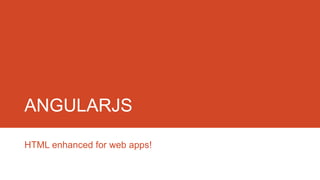
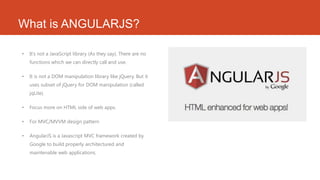
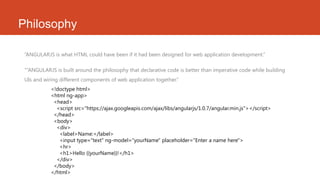


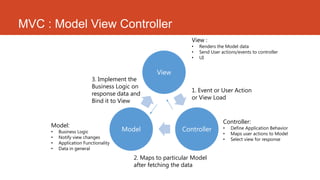

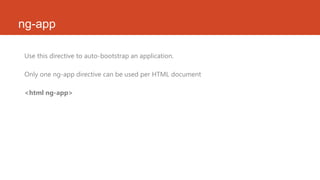

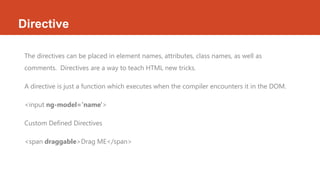
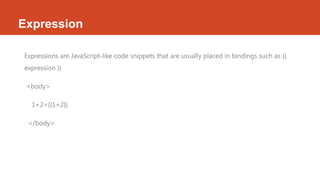
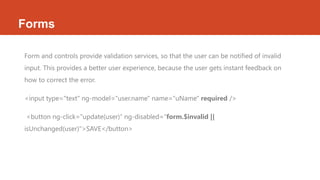
![Module
Modules declaratively specify how an application should be bootstrapped.
There can be multiple modules in an app
Those could be interdependent too.
// declare a module
var myAppModule = angular.module('myApp', [--here goes the dependent Modules--]);
Modules are configured with routes, controllers, models etc.](https://image.slidesharecdn.com/kishankumarappfinz-200207131646/85/Introduction-to-Angularjs-kishan-kumar-13-320.jpg)
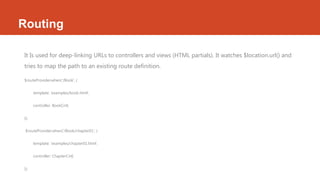


![Filters
Angular filters format data for display to the user.
{{ expression [| filter_name[:parameter_value] ... ] }}
{{ uppercase_expression | uppercase }}
{{ expression | filter1 | filter2 }}
Can create custom filters](https://image.slidesharecdn.com/kishankumarappfinz-200207131646/85/Introduction-to-Angularjs-kishan-kumar-17-320.jpg)


Recommended
Introduction to Angular Js



Introduction to Angular JsProfessional Guru
?
AngularJS is a structural framework for dynamic web apps. It lets you use HTML as your template language and lets you extend HTML's syntax to express your application's components clearly and succinctly. AngularJS's data binding and dependency injection eliminate much of the code you would otherwise have to write. And it all happens within the browser, making it an ideal partner with any server technology.AngularJs (1.x) Presentation



AngularJs (1.x) PresentationRaghubir Singh
?
AngularJS (1.x) is a client-side framework for developing browser-based applications using model-view-whatever architecture. It was created by Google and is open source. AngularJS uses templates, modules, services, dependency injection and two-way data binding to build single page applications. Key features include bootstrapping, routing, directives and unit testing capabilities. Angular 2 is a complete rewrite of AngularJS and uses only class-based services rather than multiple options.Angular js 1.3 presentation for fed nov 2014



Angular js 1.3 presentation for fed nov 2014Sarah Hudson
?
AngularJS is an up-and-coming JavaScript framework supported and maintained by Google. Over the past year, usage for the framework has exploded, giving many developers reason to believe it's the next big thing. In this presentation by Angular developer Sarah Hudson, you will learn the basics of what Angular is and what it can do for your projects, as well as breaking down the components of Angular, what makes it unique, and how it gives developers more control over custom templates and elements.
Sections include:
? Core structure and components of Angular, such as custom directives, factories for sharing data, two-way binding, and modules
? Companion libraries to Angular, such as the popular AngularUI suite which includes UI-Bootstrap
? A brief overview of routing options from Angular's native routing to UI Router, and how it offers flexibility for your appsAngular js presentation at Datacom



Angular js presentation at DatacomDavid Xi Peng Yang
?
This document provides an introduction and overview of the Angular JS framework. It discusses key features like two-way data binding, directives, dependency injection and routing. It also outlines how Angular enables building single page applications with rich client-side functionality that communicate with APIs via REST. Finally, it demonstrates setting up a sample application using tools like NPM, Yeoman, Bower and Grunt.AngularJS - introduction & how it works?



AngularJS - introduction & how it works?Alexe Bogdan
?
Angular Framework: Key Features & Data Binding.
Full presentation here: http://slides.com/alexebogdan/angular-introductionIntroduction of angular js



Introduction of angular jsTamer Solieman
?
Introduction to AngularJS
????? ?? AngularJS
Follow us on Egyptian NodeJs Community on google+
https://plus.google.com/u/0/communities/110403046378899425503
Angular Project Report



Angular Project ReportKodexhub
?
Deepanshu thanks Lovely Professional University for providing him the opportunity to complete a project on Angular 6. He learned a lot and is grateful for the experience. He also thanks his parents and friend for their help in finalizing the project within the limited timeframe. The document then provides summaries of key aspects of Angular 6, including its architecture which follows an MVC pattern, forms, data binding, pipes, services, routing, and modules.Introduction to AngularJS



Introduction to AngularJSDavid Parsons
?
AngularJS is an open source JavaScript framework maintained by Google that extends HTML with new elements and attributes. It uses a Model-View-Whatever architecture to develop single-page applications. Key AngularJS components include directives, expressions, and controllers that allow two-way data binding between models and views.Introduction to single page application with angular js



Introduction to single page application with angular jsMindfire Solutions
?
This document summarizes a presentation on AngularJS. It introduces AngularJS as a JavaScript framework for building single-page applications. It covers key AngularJS concepts like modules, controllers, views, directives, routing, services, filters and custom directives. It also provides examples of creating modules, controllers and views, using directives for data binding, implementing routing and dependency injection. The presentation concludes by discussing upcoming topics like custom directives, isolated scopes, services and testing with AngularJS.AngularJS: Overview & Key Features



AngularJS: Overview & Key FeaturesMohamad Al Asmar
?
Agenda:
1- Introduction: basic description and overview about what is angular and why we should use it.
2- AngularJS Core Features: key features of angularJS.
3- Guides and help: API and documentation references, in addition of online courses.Angular js



Angular jsKnoldus Inc.
?
We Will learn about:
What is AngularJs?
Key Points
Core Features of AngularJS
How is it works?
AngularJs Terminologies
AngularJs directives
How we start work on AngularJs?
AngularJs Tags
How we use Yeoman?
Advantages and Disadvantages
Angular js



Angular jsMindtree
?
Angular js is an open source JavaScript framework developed by Google. It is commonly used to build single page applications, especially in domains like banking, finance, and e-commerce. Angular's MVC framework allows developers to write less code and build applications that are easier to test. The framework uses HTML enhancement techniques like data binding, directives, services and dependency injection to facilitate the creation of reusable components.ASP .net MVC



ASP .net MVCDivya Sharma
?
This document provides an overview of ASP.net MVC, including what MVC is, how ASP.net MVC request execution works, details on controllers, routing, application development, differences from web forms, and when to use MVC. It describes MVC as separating applications into models, views, and controllers, and how ASP.net MVC implements the MVC pattern with controllers handling user input and selecting views. Request processing and controller lifecycles are also summarized at a high level.MVVM In Use



MVVM In UseChris Charabaruk
?
This document discusses the Model-View-ViewModel (MVVM) pattern for building user interfaces. It describes the roles of the Model, View, and ViewModel components, with the Model containing business logic/data, the View containing the user interface, and the ViewModel connecting the two and containing application logic. It also covers how bindings and commands allow the View and ViewModel to communicate and transfer data, with bindings declared in the View and commands implemented in the ViewModel. Finally, it mentions demo applications that illustrate basic and advanced MVVM concepts.What is MVC?



What is MVC?Dom Cimafranca
?
The document discusses Model-View-Controller (MVC), an architectural pattern that separates application logic from presentation, improving modularity and loose coupling between components. MVC divides applications into three components - the model, the view, and the controller, with the controller receiving input and calling methods on model objects that change their state, and the view being updated based on changes in the model. Several popular web frameworks that implement the MVC pattern are also listed.Angularjs PPT



Angularjs PPTAmit Baghel
?
This document summarizes the history and benefits of AngularJS. It explains that AngularJS was originally created in 2009 as a side project by Misko Hevery and Adam Abrons to build a tool for both front-end and back-end development. When working on a Google project called Google Feedback, Hevery was able to rewrite 17,000 lines of code into 1,500 lines using his AngularJS framework by taking advantage of its features like separation of concerns, modularity, and reusable components. The document then lists some key benefits of AngularJS like being lightweight, free, and improving structure, quality, organization and maintainability of code.MVC architecture



MVC architectureEmily Bauman
?
The document describes the Model-View-Controller (MVC) architecture pattern for web applications. It consists of three components: the Model manages and represents the application's data, the View displays the data to the user, and the Controller handles interactions between the Model and View. Many frameworks like Spring and Ruby on Rails have adopted MVC concepts. The document then provides a specific example of using the Spring MVC framework to build a web application with the MVC pattern.ASP.NET MVC Presentation



ASP.NET MVC PresentationVolkan Uzun
?
This document discusses ASP.NET MVC, an open source web application framework that implements the model-view-controller pattern. It provides an overview of ASP.NET MVC, including its advantages over ASP.NET Web Forms such as more control over HTML, easier testing, and support for clean URLs. The document also covers best practices for ASP.NET MVC projects, including separating concerns between models, views, and controllers, using dependency injection, avoiding direct dependencies between components, and writing tests.Introduction to AngularJS Framework



Introduction to AngularJS FrameworkRaveendra R
?
AngularJS is a JavaScript framework made by Google for building complex client-side applications.
Angular.js is a MVW (Model-View-Whatever) open-source JavaScript web framework that facilitates the creation of single-page applications (SPA) and data-driven apps.
Angular projects have a somewhat different structure than other JavaScript MVC frameworks, but it can be highly modular and easy to maintain once you understand the structure.
AngularJS is a JavaScript MVC framework developed by Google that lets you build well structured, easily testable, and maintainable front-end applications
Mvc pattern and implementation in java fair



Mvc pattern and implementation in java fairTech_MX
?
The document discusses the MVC pattern for developing user interfaces, which separates an application into three components - the model manages the core data and logic, the view handles visual presentation of the data to the user, and the controller receives user input and translates it into actions on the model. The MVC pattern promotes separation of concerns, makes the code more modular and reusable, and allows independent development and updating of each component without impacting the others. Common implementations of MVC involve the model notifying subscribed views of any data changes, the controller handling user input to update the model and selecting views, and views updating their presentation when the model changes.MVC Architecture



MVC ArchitecturePrasanna Venkatesh
?
The document discusses the Model-View-Controller (MVC) design pattern which assigns objects in an application one of three roles: model, view, or controller. The pattern defines how these objects communicate with each other. MVC is central to a good design for Cocoa applications as it promotes reusability, extensibility, and is the basis for many Cocoa technologies. Model objects define the application's data logic. View objects display data and enable user interaction. Controller objects act as intermediaries between models and views.Asp.net mvc



Asp.net mvcNaga Harish M
?
The document discusses ASP.NET MVC, which is a web development framework that follows the model-view-controller architectural pattern. It allows separating an application's data model, user interface, and application logic. ASP.NET MVC brings this development approach to ASP.NET, allowing developers to build dynamic, testable and SEO-friendly websites and applications. Some benefits of ASP.NET MVC include better support for unit testing, complete control over HTML, and enabling rich AJAX functionality. It also avoids some of the overhead of traditional ASP.NET forms applications.ASP .NET MVC Introduction & Guidelines 



ASP .NET MVC Introduction & Guidelines Dev Raj Gautam
?
This presentation is foucsed on Introduction to MVC. Aimed at .NET developers that are total beginners in the Web Applications world and want to get started using familiar Microsoft .NET technologies.
For the existing ASP.NET web form user this slides provides and idea about what are the advatages of using MVC, tradeoffs between MVC and Web Forms.Angular js



Angular jsvu van quyet
?
AngularJS is a JavaScript MVC framework created by Google to build properly architectured and maintainable web applications. It uses declarative code and two-way data binding between the model and view. Key features include services, filters, directives, templates and routing to switch between views. Modules are containers that group controllers, filters, services etc. Routing is used to switch between views in a single page application. Factories can be used to share data between controllers.MVC Architecture



MVC Architecturebaabtra.com - No. 1 supplier of quality freshers
?
This document provides an overview of the Model-View-Controller (MVC) architecture pattern. It explains that MVC separates an application's data (model), user interface (view), and logic/control (controller) to allow for more modular and maintainable code. The model manages the data, the view displays it, and the controller handles input and updates the model or view. MVC originated in Smalltalk and became popular for web applications, where the layers can run on separate platforms. It is commonly used today due to its ability to separate concerns in user interfaces.MVC Seminar Presantation



MVC Seminar PresantationAbhishek Yadav
?
As a part of the course work we were supposed to prepare a seminar on any topic of Interest, So we tried to demystify MVC as a Design pattern.Intoduction to Angularjs



Intoduction to AngularjsGaurav Agrawal
?
AngularJS is an open source JavaScript framework for building dynamic web applications. It enhances HTML with custom directives and bindings to enrich client-side web applications with reusable components. Key features include two-way data binding, reusable components, support for MVC/MVVM design patterns, end-to-end testing, cross-browser compatibility, and services. AngularJS allows developers to organize applications into modules and controllers to keep code clean and reusable.Why MVC?



Why MVC?Wayne Tun Myint
?
This is my presentation for Developer Conference Myanmar 2013. It explains about the benefits and usages of MVC Architecture Design Pattern)introduction to Angularjs basics



introduction to Angularjs basicsRavindra K
?
Angularjs is a client side javascript framework that adds interactivity to HTML. It allows developers to create dynamic and interactive web applications. Some key features include directives, modules, controllers, expressions and data binding. Directives are HTML annotations that trigger javascript behaviors. Modules group application components. Controllers add application logic and behavior. Expressions display dynamic values in the HTML. Angularjs uses MVC architecture with the view being the DOM, controllers handling logic, and models storing data. It also utilizes dependency injection to manage dependencies between components.Introduction to AngularJS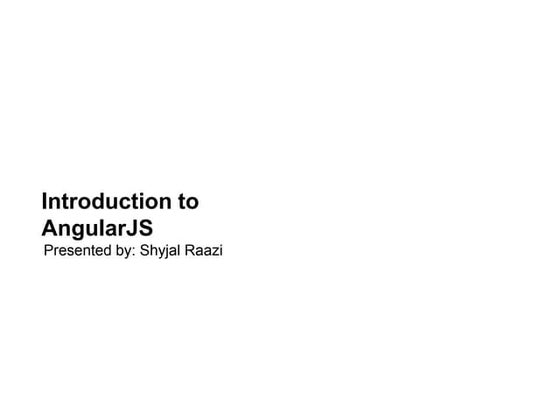



Introduction to AngularJSShyjal Raazi
?
1) The document introduces AngularJS, a framework for building single-page applications. It discusses why frameworks are needed for SPAs and highlights features of AngularJS like two-way data binding, directives, controllers, and routing.
2) The agenda covers AngularJS concepts like templates, directives, data binding, scopes, controllers, modules, filters, services, and routing. It also explains how an Angular app starts and how views interact with controllers.
3) Examples are provided to demonstrate two-way data binding, directives, controllers, and routing in AngularJS. Links are included for further learning on AngularJS tutorials and documentation.More Related Content
What's hot (20)
Introduction to single page application with angular js



Introduction to single page application with angular jsMindfire Solutions
?
This document summarizes a presentation on AngularJS. It introduces AngularJS as a JavaScript framework for building single-page applications. It covers key AngularJS concepts like modules, controllers, views, directives, routing, services, filters and custom directives. It also provides examples of creating modules, controllers and views, using directives for data binding, implementing routing and dependency injection. The presentation concludes by discussing upcoming topics like custom directives, isolated scopes, services and testing with AngularJS.AngularJS: Overview & Key Features



AngularJS: Overview & Key FeaturesMohamad Al Asmar
?
Agenda:
1- Introduction: basic description and overview about what is angular and why we should use it.
2- AngularJS Core Features: key features of angularJS.
3- Guides and help: API and documentation references, in addition of online courses.Angular js



Angular jsKnoldus Inc.
?
We Will learn about:
What is AngularJs?
Key Points
Core Features of AngularJS
How is it works?
AngularJs Terminologies
AngularJs directives
How we start work on AngularJs?
AngularJs Tags
How we use Yeoman?
Advantages and Disadvantages
Angular js



Angular jsMindtree
?
Angular js is an open source JavaScript framework developed by Google. It is commonly used to build single page applications, especially in domains like banking, finance, and e-commerce. Angular's MVC framework allows developers to write less code and build applications that are easier to test. The framework uses HTML enhancement techniques like data binding, directives, services and dependency injection to facilitate the creation of reusable components.ASP .net MVC



ASP .net MVCDivya Sharma
?
This document provides an overview of ASP.net MVC, including what MVC is, how ASP.net MVC request execution works, details on controllers, routing, application development, differences from web forms, and when to use MVC. It describes MVC as separating applications into models, views, and controllers, and how ASP.net MVC implements the MVC pattern with controllers handling user input and selecting views. Request processing and controller lifecycles are also summarized at a high level.MVVM In Use



MVVM In UseChris Charabaruk
?
This document discusses the Model-View-ViewModel (MVVM) pattern for building user interfaces. It describes the roles of the Model, View, and ViewModel components, with the Model containing business logic/data, the View containing the user interface, and the ViewModel connecting the two and containing application logic. It also covers how bindings and commands allow the View and ViewModel to communicate and transfer data, with bindings declared in the View and commands implemented in the ViewModel. Finally, it mentions demo applications that illustrate basic and advanced MVVM concepts.What is MVC?



What is MVC?Dom Cimafranca
?
The document discusses Model-View-Controller (MVC), an architectural pattern that separates application logic from presentation, improving modularity and loose coupling between components. MVC divides applications into three components - the model, the view, and the controller, with the controller receiving input and calling methods on model objects that change their state, and the view being updated based on changes in the model. Several popular web frameworks that implement the MVC pattern are also listed.Angularjs PPT



Angularjs PPTAmit Baghel
?
This document summarizes the history and benefits of AngularJS. It explains that AngularJS was originally created in 2009 as a side project by Misko Hevery and Adam Abrons to build a tool for both front-end and back-end development. When working on a Google project called Google Feedback, Hevery was able to rewrite 17,000 lines of code into 1,500 lines using his AngularJS framework by taking advantage of its features like separation of concerns, modularity, and reusable components. The document then lists some key benefits of AngularJS like being lightweight, free, and improving structure, quality, organization and maintainability of code.MVC architecture



MVC architectureEmily Bauman
?
The document describes the Model-View-Controller (MVC) architecture pattern for web applications. It consists of three components: the Model manages and represents the application's data, the View displays the data to the user, and the Controller handles interactions between the Model and View. Many frameworks like Spring and Ruby on Rails have adopted MVC concepts. The document then provides a specific example of using the Spring MVC framework to build a web application with the MVC pattern.ASP.NET MVC Presentation



ASP.NET MVC PresentationVolkan Uzun
?
This document discusses ASP.NET MVC, an open source web application framework that implements the model-view-controller pattern. It provides an overview of ASP.NET MVC, including its advantages over ASP.NET Web Forms such as more control over HTML, easier testing, and support for clean URLs. The document also covers best practices for ASP.NET MVC projects, including separating concerns between models, views, and controllers, using dependency injection, avoiding direct dependencies between components, and writing tests.Introduction to AngularJS Framework



Introduction to AngularJS FrameworkRaveendra R
?
AngularJS is a JavaScript framework made by Google for building complex client-side applications.
Angular.js is a MVW (Model-View-Whatever) open-source JavaScript web framework that facilitates the creation of single-page applications (SPA) and data-driven apps.
Angular projects have a somewhat different structure than other JavaScript MVC frameworks, but it can be highly modular and easy to maintain once you understand the structure.
AngularJS is a JavaScript MVC framework developed by Google that lets you build well structured, easily testable, and maintainable front-end applications
Mvc pattern and implementation in java fair



Mvc pattern and implementation in java fairTech_MX
?
The document discusses the MVC pattern for developing user interfaces, which separates an application into three components - the model manages the core data and logic, the view handles visual presentation of the data to the user, and the controller receives user input and translates it into actions on the model. The MVC pattern promotes separation of concerns, makes the code more modular and reusable, and allows independent development and updating of each component without impacting the others. Common implementations of MVC involve the model notifying subscribed views of any data changes, the controller handling user input to update the model and selecting views, and views updating their presentation when the model changes.MVC Architecture



MVC ArchitecturePrasanna Venkatesh
?
The document discusses the Model-View-Controller (MVC) design pattern which assigns objects in an application one of three roles: model, view, or controller. The pattern defines how these objects communicate with each other. MVC is central to a good design for Cocoa applications as it promotes reusability, extensibility, and is the basis for many Cocoa technologies. Model objects define the application's data logic. View objects display data and enable user interaction. Controller objects act as intermediaries between models and views.Asp.net mvc



Asp.net mvcNaga Harish M
?
The document discusses ASP.NET MVC, which is a web development framework that follows the model-view-controller architectural pattern. It allows separating an application's data model, user interface, and application logic. ASP.NET MVC brings this development approach to ASP.NET, allowing developers to build dynamic, testable and SEO-friendly websites and applications. Some benefits of ASP.NET MVC include better support for unit testing, complete control over HTML, and enabling rich AJAX functionality. It also avoids some of the overhead of traditional ASP.NET forms applications.ASP .NET MVC Introduction & Guidelines 



ASP .NET MVC Introduction & Guidelines Dev Raj Gautam
?
This presentation is foucsed on Introduction to MVC. Aimed at .NET developers that are total beginners in the Web Applications world and want to get started using familiar Microsoft .NET technologies.
For the existing ASP.NET web form user this slides provides and idea about what are the advatages of using MVC, tradeoffs between MVC and Web Forms.Angular js



Angular jsvu van quyet
?
AngularJS is a JavaScript MVC framework created by Google to build properly architectured and maintainable web applications. It uses declarative code and two-way data binding between the model and view. Key features include services, filters, directives, templates and routing to switch between views. Modules are containers that group controllers, filters, services etc. Routing is used to switch between views in a single page application. Factories can be used to share data between controllers.MVC Architecture



MVC Architecturebaabtra.com - No. 1 supplier of quality freshers
?
This document provides an overview of the Model-View-Controller (MVC) architecture pattern. It explains that MVC separates an application's data (model), user interface (view), and logic/control (controller) to allow for more modular and maintainable code. The model manages the data, the view displays it, and the controller handles input and updates the model or view. MVC originated in Smalltalk and became popular for web applications, where the layers can run on separate platforms. It is commonly used today due to its ability to separate concerns in user interfaces.MVC Seminar Presantation



MVC Seminar PresantationAbhishek Yadav
?
As a part of the course work we were supposed to prepare a seminar on any topic of Interest, So we tried to demystify MVC as a Design pattern.Intoduction to Angularjs



Intoduction to AngularjsGaurav Agrawal
?
AngularJS is an open source JavaScript framework for building dynamic web applications. It enhances HTML with custom directives and bindings to enrich client-side web applications with reusable components. Key features include two-way data binding, reusable components, support for MVC/MVVM design patterns, end-to-end testing, cross-browser compatibility, and services. AngularJS allows developers to organize applications into modules and controllers to keep code clean and reusable.Why MVC?



Why MVC?Wayne Tun Myint
?
This is my presentation for Developer Conference Myanmar 2013. It explains about the benefits and usages of MVC Architecture Design Pattern)Similar to Introduction to Angularjs : kishan kumar (20)
introduction to Angularjs basics



introduction to Angularjs basicsRavindra K
?
Angularjs is a client side javascript framework that adds interactivity to HTML. It allows developers to create dynamic and interactive web applications. Some key features include directives, modules, controllers, expressions and data binding. Directives are HTML annotations that trigger javascript behaviors. Modules group application components. Controllers add application logic and behavior. Expressions display dynamic values in the HTML. Angularjs uses MVC architecture with the view being the DOM, controllers handling logic, and models storing data. It also utilizes dependency injection to manage dependencies between components.Introduction to AngularJS



Introduction to AngularJSShyjal Raazi
?
1) The document introduces AngularJS, a framework for building single-page applications. It discusses why frameworks are needed for SPAs and highlights features of AngularJS like two-way data binding, directives, controllers, and routing.
2) The agenda covers AngularJS concepts like templates, directives, data binding, scopes, controllers, modules, filters, services, and routing. It also explains how an Angular app starts and how views interact with controllers.
3) Examples are provided to demonstrate two-way data binding, directives, controllers, and routing in AngularJS. Links are included for further learning on AngularJS tutorials and documentation.Kalp Corporate Angular Js Tutorials



Kalp Corporate Angular Js TutorialsKalp Corporate
?
1> IMPORTANT PARTS OF ANGULARJS
2> Angular Js FEATURES
3> ADVANTAGES / DISADVANTAGES OF ANGULARJS
4> THE ANGULARJS COMPONENTS
5> MVC
6> STEPS TO CREATE ANGULARJS APPLearning AngularJS - Complete coverage of AngularJS features and concepts



Learning AngularJS - Complete coverage of AngularJS features and conceptsSuresh Patidar
?
AngularJS learning sessions tailored for 6 days/12 hours. Complete coverage of AngularJS features that will be helpful for both beginner as well as expert. Also covers common development use cases and their answer/solution in AngularJS. A good coverage on tooling required for development and testing.AngularJS



AngularJSSrivatsan Krishnamachari
?
The document provides an agenda and overview of key concepts in AngularJS including single page applications, directives, data binding, MVC pattern, modules, routes, factories and services. It discusses downloading and setting up AngularJS, its building blocks like views, controllers and models. It also provides examples of using directives for data binding, iteration, conditional display, and creating custom directives.Angular Js Get Started - Complete Course



Angular Js Get Started - Complete CourseEPAM Systems
?
This document provides an introduction and overview of AngularJS, including:
- AngularJS is a JavaScript framework for building dynamic web applications and sites. It allows building applications that run in web browsers using HTML.
- Key AngularJS concepts covered include directives, controllers, modules, services, filters, forms, routing and two-way data binding.
- Examples are provided to demonstrate how to create AngularJS applications, controllers, directives, filters and more.
- Custom directives and services can be created to extend the functionality of AngularJS applications.Starting with angular js 



Starting with angular js jagriti srivastava
?
This document provides an overview of the steps to create a basic AngularJS application, including referencing the AngularJS framework, defining an Angular module, adding controllers, using directives like ng-app and ng-controller, binding the view to the model with ng-model, and implementing two-way data binding between the view and model.Training On Angular Js



Training On Angular JsMahima Radhakrishnan
?
This document provides an overview of AngularJS, including:
- AngularJS is an open source JavaScript framework for building single page applications. It extends HTML with directives and two-way data binding.
- Core AngularJS concepts include modules, controllers, scopes, templates, and data binding. AngularJS uses MVVM pattern rather than traditional MVC.
- Templates define the view and use bindings, filters and directives to display dynamic data from the model. Controllers manipulate the model and expose it to templates via scopes.Angularjs



AngularjsSabin Tamrakar
?
AngularJS is a JavaScript MVC framework created by Google to build maintainable web applications. It was released in 2012 and focuses on HTML and MVC/MVVM design patterns. Key features include data binding, controllers, directives, expressions, forms, modules, scopes, dependency injection, filters and services.Client Side MVC & Angular



Client Side MVC & AngularAlexe Bogdan
?
About MVC Pattern and how its applied on a client-side environment
Full presentation: https://slides.com/alexebogdan/client-side-mvc-angularOverview of the AngularJS framework 



Overview of the AngularJS framework Yakov Fain
?
This is a slide deck from our training class "Modern Web Development for Java Developers" that I taught in March of 2015.Angularjs Basics



Angularjs BasicsAnuradha Bandara
?
The document discusses how web pages are created using HTML, CSS, and JavaScript. It explains the Document Object Model (DOM) and how JavaScript can manipulate the DOM. It then provides an overview of AngularJS including what it is, how it works, and some key concepts like directives, dependency injection, services, and data binding.AngularJS 101 - Everything you need to know to get started



AngularJS 101 - Everything you need to know to get startedSt└phane B└gaudeau
?
In this presentation, you will find everything need to get started with AngularJS.
For more details, have a look at my blog (http://stephanebegaudeau.tumblr.com) or follow me on twitter (@sbegaudeau)Understanding angular js



Understanding angular jsAayush Shrestha
?
This document provides an overview of AngularJS, including its core features and concepts. It discusses how AngularJS is a client-side JavaScript framework that uses MVC architecture. Key points covered include two-way data binding, templates, dependency injection, modules, controllers, views, models, scopes, filters, services, and directives. Custom directives and their creation are demonstrated. The document aims to give attendees an introduction to AngularJS and its basic building blocks.MVC 4



MVC 4Vasilios Kuznos
?
The document discusses the Model-View-Controller (MVC) pattern and ASP.NET MVC framework. It describes the key components of MVC - the Model, View and Controller. The Controller handles communication from the user, application flow and logic. The Model represents application data and business rules. The View displays the user interface. ASP.NET MVC is an MVC web application framework for ASP.NET that was open sourced by Microsoft. New versions of ASP.NET MVC added features like Razor view engine, model validation, and Web API for building HTTP services.Single Page Application



Single Page ApplicationPrasad Narasimhan
?
The document discusses single page applications (SPAs) and how AngularJS can be used to build them. Some key points:
- SPAs load all necessary code (HTML, CSS, JavaScript) with a single page load and update dynamically without reloading the page. This provides a more desktop-like user experience.
- AngularJS supports building SPAs through features like data binding, scopes, controllers, services, and directives that help manage state and update the view.
- In an AngularJS SPA, the server handles CRUD operations and authentication through a REST API, while the client manages the UI, makes AJAX calls, and performs routing and validation.
- AngularJSAngularJS is awesome



AngularJS is awesomeEusebiu Schipor
?
AngularJS is a client-side JavaScript framework that allows developers to create single page applications. It provides two-way data binding, MVC architecture, templates and custom directives to help build testable web apps that can scale. Some key features include data binding, controllers, expressions to dynamically display data, modules to organize code, and services to handle back-end communication. Overall, AngularJS streamlines web development by handling many common tasks like DOM manipulation, data binding and communication with backend services.Angular workshop - Full Development Guide



Angular workshop - Full Development GuideNitin Giri
?
AngularJS provides powerful tools for building single page applications, including data binding, scopes, controllers, directives, filters and forms validation. It follows an MVC pattern with two-way data binding between models and views. Key features include directives for creating custom HTML elements, filters for formatting data and built-in validation for forms. AngularJS aims to improve frontend development by reducing code and server interactions.Angular introduction basic



Angular introduction basicjagriti srivastava
?
AngularJS is a JavaScript framework for building browser-based applications that uses a Model-View-Controller pattern. It allows defining custom tags in HTML and uses two-way data binding between models and views. AngularJS applications are cross-browser compliant and use less code than traditional JavaScript apps due to features like dependency injection and built-in services. The framework encapsulates portions of a page into single pages and makes applications easier to test, develop, and maintain.AngularJs Workshop SDP December 28th 2014



AngularJs Workshop SDP December 28th 2014Ran Wahle
?
This document provides an overview and agenda for a training on AngularJS. It introduces key concepts in AngularJS like modules, dependency injection, data binding with controllers and scopes, services, filters, directives, forms, and routing. Code examples are provided to demonstrate creating modules, controllers, services, binding data between the view and model, and using built-in and custom directives. The training will cover building AngularJS applications with a focus on best practices.Recently uploaded (20)
2025-04-05 - Block71 Event - The Landscape of GenAI and Ecosystem.pdf



2025-04-05 - Block71 Event - The Landscape of GenAI and Ecosystem.pdfIvan Tang
?
The different layers of GenAI stack.Artificial Neural Networks, basics, its variations and examples



Artificial Neural Networks, basics, its variations and examplesanandsimple
?
The slides describe basics of Artificial Neural Networks, its variations and examples in details.How Telemedicine App Development is Revolutionizing Virtual Care.pptx



How Telemedicine App Development is Revolutionizing Virtual Care.pptxDash Technologies Inc
?
Telemedicine app development builds software for remote doctor consultations and patient check-ups. These apps bridge healthcare professionals with patients via video calls, secure messages, and interactive interfaces. That helps practitioners to provide care without immediate face-to-face interactions; hence, simplifying access to medical care. Telemedicine applications also manage appointment scheduling, e-prescribing, and sending reminders.
Telemedicine apps do not only conduct remote consultations. They also integrate with entire healthcare platforms, such as patient forums, insurance claims processing, and providing medical information libraries. Remote patient monitoring enables providers to keep track of patients' vital signs. This helps them intervene and provide care whenever necessary. Telehealth app development eliminates geographical boundaries and facilitates easier communication.
In this blog, we will explore its market growth, essential features, and benefits for both patients and providers. AI in Talent Acquisition: Boosting Hiring



AI in Talent Acquisition: Boosting HiringBeyond Chiefs
?
AI is transforming talent acquisition by streamlining recruitment processes, enhancing decision-making, and delivering personalized candidate experiences. By automating repetitive tasks such as resume screening and interview scheduling, AI significantly reduces hiring costs and improves efficiency, allowing HR teams to focus on strategic initiatives. Additionally, AI-driven analytics help recruiters identify top talent more accurately, leading to better hiring decisions. However, despite these advantages, organizations must address challenges such as AI bias, integration complexities, and resistance to adoption to fully realize its potential. Embracing AI in recruitment can provide a competitive edge, but success depends on aligning technology with business goals and ensuring ethical, unbiased implementation.
Ricardo Jebb Bruno - A Structural CAD Technician



Ricardo Jebb Bruno - A Structural CAD TechnicianRicardo Jebb Bruno
?
Ricardo Jebb Bruno is a skilled Structural CAD Technician with over 10 years of experience. He specializes in structural analysis, design, and project management, and is proficient in AutoCAD, Revit, and SolidWorks. A graduate of the University of Miami with a degree in Civil Engineering, he currently works at Metrix Structural Group. Ricardo is a member of the American Society of Civil Engineers and the National CAD Society, and volunteers with Habitat for Humanity. His hobbies include 3D printing and sci-fi media.All-Data, Any-AI Integration: FME & Amazon Bedrock in the Real-World



All-Data, Any-AI Integration: FME & Amazon Bedrock in the Real-WorldSafe Software
?
Join us for an exclusive webinar featuring special guest speakers from Amazon, Amberside Energy, and Avineon-Tensing as we explore the power of Amazon Bedrock and FME in AI-driven geospatial workflows.
Discover how Avineon-Tensing is using AWS Bedrock to support Amberside Energy in automating image classification and streamlining site reporting. By integrating Bedrock¨s generative AI capabilities with FME, image processing and categorization become faster and more efficient, ensuring accurate and organized filing of site imagery. Learn how this approach reduces manual effort, standardizes reporting, and leverages AWS¨s secure AI tooling to optimize their workflows.
If you¨re looking to enhance geospatial workflows with AI, automate image processing, or simply explore the potential of FME and Bedrock, this webinar is for you!Draginoプロダクトカタログ LoRaWAN NB-IoT LTE cat.M1斌瞳リスト



Draginoプロダクトカタログ LoRaWAN NB-IoT LTE cat.M1斌瞳リストCRI Japan, Inc.
?
Draginoプロダクトカタログ LoRaWAN NB-IoT LTE cat.M1斌瞳リストCybersecurity-Threat-Landscape-March-31-April-7-2025.pdf



Cybersecurity-Threat-Landscape-March-31-April-7-2025.pdfJoe Shenouda
?
Weekly cyber hits: NK hackers drop BeaverTail via 11 npm pkgs (5.6k dl¨s) targeting devs. Ivanti flaw (CVE-2025-22457) hit by China pros!patch by 4/11! PoisonSeed spams Coinbase; PyPI pkgs (39k dl¨s) swipe data. Lock it down! Like & share for more!Network_Packet_Brokers_Presentation.pptx



Network_Packet_Brokers_Presentation.pptxKhushi Communications
?
Most people might think of a water faucet or even the tap on a keg of beer. But in the world of networking, "TAP" stands for "Traffic Access Point" or "Test Access Point." It's not a beverage or a sink fixture, but rather a crucial tool for network monitoring and testing. Khushi Communications is a top vendor in India, providing world-class Network TAP solutions. With their expertise, they help businesses monitor, analyze, and secure their networks efficiently.Sugarlab AI: How Much Does an XXX AI Porn Generator Cost in 2025



Sugarlab AI: How Much Does an XXX AI Porn Generator Cost in 2025Sugarlab AI
?
The cost of an XXX AI porn generator in 2025 varies depending on factors like AI sophistication, subscription plans, and additional expenses. Whether you're looking for a free AI porn video generator or a premium adult AI image generator, pricing ranges from basic tools to enterprise-level solutions. This article breaks down the costs, features, and what to expect from AI-driven adult content platforms.The metaverse : A Digital Transformation



The metaverse : A Digital Transformationmatlotloatang03
?
Dive into the fascinating world of the metaverse,a digital universe that blends virtual , augmented reality.UiPath NY AI Series: Session 4: UiPath AutoPilot for Developers using Studio Web



UiPath NY AI Series: Session 4: UiPath AutoPilot for Developers using Studio WebDianaGray10
?
Welcome to session 4 of the UiPath AI series. In this session, you will learn about UiPath Autopilot for Developers using Studio Web.San Francisco Atlassian ACE - Mar 27 2025.pdf



San Francisco Atlassian ACE - Mar 27 2025.pdfMatt Doar
?
際際滷s from 7 vendors at. the Atlassian ACE event in SF on March 27th 2025Solana Developer Hiring for Enterprises Key Considerations.pdf



Solana Developer Hiring for Enterprises Key Considerations.pdfLisa ward
?
Key considerations for hiring Solana developers in enterprises include expertise in Rust, smart contracts, Solana SDKs, security, and scalability.
AuthZEN The OpenID Connect of Authorization - Gartner IAM EMEA 2025



AuthZEN The OpenID Connect of Authorization - Gartner IAM EMEA 2025David Brossard
?
Today, the authorization world is fractured - each vendor supports its own APIs & protocols. But this is about to change: OpenID AuthZEN was created in late 2023 to establish much-needed modern authorization standards. As of late 2024, AuthZEN has a stable Implementers Draft, and is expected to reach Final Specification in 2025.
With AuthZEN, IAM teams can confidently externalize and standardize authorization across their application estate without being locked in to a proprietary API.
This session will describe the state of modern authorization, review the AuthZEN API, and demo our 15 interoperable implementations.Mastering Azure Durable Functions - Building Resilient and Scalable Workflows



Mastering Azure Durable Functions - Building Resilient and Scalable WorkflowsCallon Campbell
?
The presentation aims to provide a comprehensive understanding of how Azure Durable Functions can be used to build resilient and scalable workflows in serverless applications. It includes detailed explanations, application patterns, components, and constraints of Durable Functions, along with performance benchmarks and new storage providers.CIOs Speak Out - A Research Series by Jasper Colin



CIOs Speak Out - A Research Series by Jasper ColinJasper Colin
?
Discover key IT leadership insights from top CIOs on AI, cybersecurity, and cost optimization. Jasper Colin¨s research reveals what¨s shaping the future of enterprise technology. Stay ahead of the curve.Automated Engineering of Domain-Specific Metamorphic Testing Environments



Automated Engineering of Domain-Specific Metamorphic Testing EnvironmentsPablo G┏mez Abajo
?
Context. Testing is essential to improve the correctness of software systems. Metamorphic testing (MT) is an approach especially suited when the system under test lacks oracles, or they are expensive to compute. However, building an MT environment for a particular domain (e.g., cloud simulation, model transformation, machine learning) requires substantial effort.
Objective. Our goal is to facilitate the construction of MT environments for specific domains.
Method. We propose a model-driven engineering approach to automate the construction of MT environments. Starting from a meta-model capturing the domain concepts, and a description of the domain execution environment, our approach produces an MT environment featuring comprehensive support for the MT process. This includes the definition of domain-specific metamorphic relations, their evaluation, detailed reporting of the testing results, and the automated search-based generation of follow-up test cases.
Results. Our method is supported by an extensible platform for Eclipse, called Gotten. We demonstrate its effectiveness by creating an MT environment for simulation-based testing of data centres and comparing with existing tools; its suitability to conduct MT processes by replicating previous experiments; and its generality by building another MT environment for video streaming APIs.
Conclusion. Gotten is the first platform targeted at reducing the development effort of domain-specific MT environments. The environments created with Gotten facilitate the specification of metamorphic relations, their evaluation, and the generation of new test cases.Leadership Spectrum by Sonam Sherpa at GDG Kathmandu March Monthly Meetup



Leadership Spectrum by Sonam Sherpa at GDG Kathmandu March Monthly MeetupGDG Kathmandu
?
Leadership by Sonam SherpaIntroduction to Angularjs : kishan kumar
- 1. ANGULARJS HTML enhanced for web apps!
- 2. What is ANGULARJS? ? It¨s not a JavaScript library (As they say). There are no functions which we can directly call and use. ? It is not a DOM manipulation library like jQuery. But it uses subset of jQuery for DOM manipulation (called jqLite). ? Focus more on HTML side of web apps. ? For MVC/MVVM design pattern ? AngularJS is a Javascript MVC framework created by Google to build properly architectured and maintenable web applications.
- 3. Philosophy ^ANGULARJS is what HTML could have been if it had been designed for web application development. ̄ ^ ̄ANGULARJS is built around the philosophy that declarative code is better than imperative code while building UIs and wiring different components of web application together. ̄ <!doctype html> <html ng-app> <head> <script src=/slideshow/introduction-to-angularjs-kishan-kumar/227276052/"https:/ajax.googleapis.com/ajax/libs/angularjs/1.0.7/angular.min.js"></script> </head> <body> <div> <label>Name:</label> <input type="text" ng-model="yourName" placeholder="Enter a name here"> <hr> <h1>Hello {{yourName}}!</h1> </div> </body> </html>
- 4. Why ANGULARJS? ? Defines numerous ways to organize web application at client side. ? Enhances HTML by attaching directives, custom tags, attributes, expressions, templates within HTML. ? Encourage TDD ? Encourage MVC/MVVM design pattern ? Code Reuse ? Good for Single Page Apps (SPA) ? Cool Features -> Next 際際滷
- 5. Key Features of ANGULARJS ? Declarative HTML approach ? Easy Data Binding : Two way Data Binding ? Reusable Components ? MVC/MVVM Design Pattern ? Dependency Injection ? End to end Integration Testing / Unit Testing ? Routing ? Templating ? Modules ? Services ? Expressions ? Filters ? Directives ? Form Validation ? $scope, $http, $routeProvider´
- 6. MVC : Model View Controller View ControllerModel 1. Event or User Action or View Load 2. Maps to particular Model after fetching the data 3. Implement the Business Logic on response data and Bind it to View View : ? Renders the Model data ? Send User actions/events to controller ? UI Controller: ? Define Application Behavior ? Maps user actions to Model ? Select view for response Model: ? Business Logic ? Notify view changes ? Application Functionality ? Data in general
- 7. MVVM: Model View ViewModel View ViewModelModel UI Presentation LogicBusiness Logic and Data ? User actions, commands ? Data binding ? Notifications ? Data Access ? Update ViewModel about change
- 8. ng-app Use this directive to auto-bootstrap an application. Only one ng-app directive can be used per HTML document <html ng-app>
- 9. HTML Compiler Angular's HTML compiler allows the developer to teach the browser new HTML syntax. The compiler allows you to attach behavior to any HTML element or attribute and even create new HTML elements or attributes with custom behavior. Angular calls these behavior extensions directives. Compiler is an angular service which traverses the DOM looking for attributes. The compilation process happens in two phases. Compile: traverse the DOM and collect all of the directives. The result is a linking function. Link: combine the directives with a scope and produce a live view. Any changes in the scope model are reflected in the view, and any user interactions with the view are reflected in the scope model. This makes the scope model the single source of truth. http://docs.angularjs.org/guide/compiler
- 10. Directive The directives can be placed in element names, attributes, class names, as well as comments. Directives are a way to teach HTML new tricks. A directive is just a function which executes when the compiler encounters it in the DOM. <input ng-model='name'> Custom Defined Directives <span draggable>Drag ME</span>
- 11. Expression Expressions are JavaScript-like code snippets that are usually placed in bindings such as {{ expression }} <body> 1+2={{1+2}} </body>
- 12. Forms Form and controls provide validation services, so that the user can be notified of invalid input. This provides a better user experience, because the user gets instant feedback on how to correct the error. <input type="text" ng-model="user.name" name="uName" required /> <button ng-click="update(user)^ ng-disabled="form.$invalid || isUnchanged(user)">SAVE</button>
- 13. Module Modules declaratively specify how an application should be bootstrapped. There can be multiple modules in an app Those could be interdependent too. // declare a module var myAppModule = angular.module('myApp', [--here goes the dependent Modules--]); Modules are configured with routes, controllers, models etc.
- 14. Routing It Is used for deep-linking URLs to controllers and views (HTML partials). It watches $location.url() and tries to map the path to an existing route definition. $routeProvider.when('/Book', { template: 'examples/book.html', controller: BookCntl, }); $routeProvider.when('/Book/chapter01', { template: 'examples/chapter01.html', controller: ChapterCntl, });
- 15. Scope Scope is an object that refers to the application model. It is an execution context for expressions. Scopes are arranged in hierarchical structure which mimic the DOM structure of the application. Scopes can watch expressions and propagate events. Actually the ViewModel of MVVM. $scope
- 16. Dependency Injection Dependency Injection (DI) is a software design pattern that deals with how code gets hold of its dependencies.
- 17. Filters Angular filters format data for display to the user. {{ expression [| filter_name[:parameter_value] ... ] }} {{ uppercase_expression | uppercase }} {{ expression | filter1 | filter2 }} Can create custom filters
- 18. Resources Documentation ? AngularJS Developer Guide ? AngularJS API ? AngularJS Tutorial Videos ? AngularJS Fundamentals In 60-ish Minutes ? Introduction to Angular JS ? AngularJS end-to-end web app tutorial Part I

